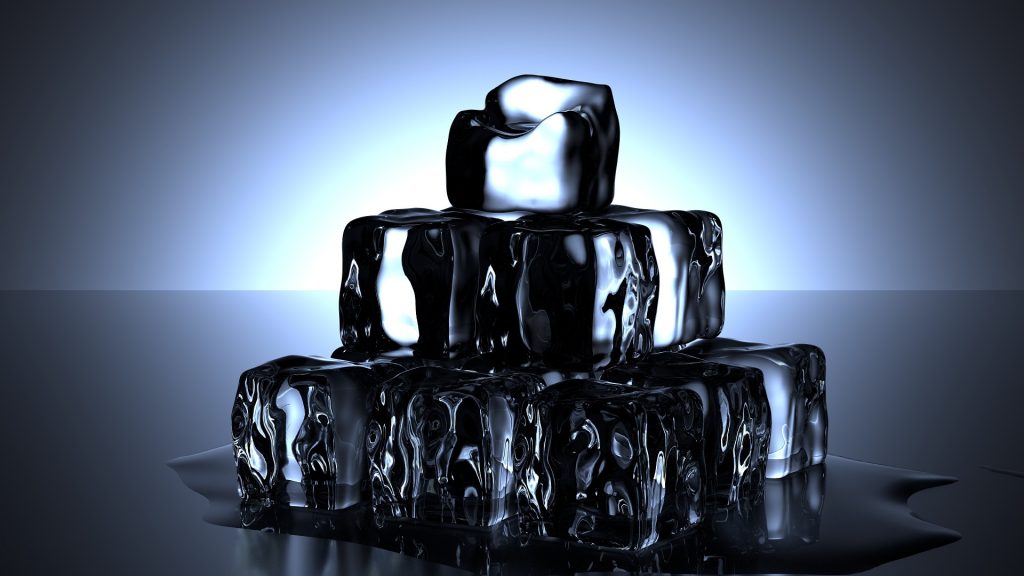How Long For The Ice to Melt?

It’s surprisingly difficult to predict the time for ice to melt. You can try a simple demonstration. Take a few ice cubes and put them on your desk or table. If you need to protect furniture you can put them on a dish, but the melting water adds to the intrigue…
First, note the obvious: Nothing will stop the melting, short of putting the ice into a freezer. The warmer it is, the faster the melting.
But the key point to grasp is that there is no way to predict precisely when the last bit of ice will have turned into water.
Very likely, the cubes will not all disappear at the same time. There are lots of variables: Factors such as the room temperature and the heat from your body, if you get close enough. Moving your hand, might change the air currents bringing warmer air to the ice. Even two apparently identical ice cubes may have slightly different mass and will almost certainly have different crystalline structure and stress cracks. All of those things will affect the rate of melting. The bigger the piece of ice, the more the variables and the unpredictability.
As a bigger example of the difficulty to predict the precise melt rate of ice, I was told this story by an MIT graduate engineer. Their class was given a very large block of ice, several feet across. The students were each asked to calculate exactly when it would be fully melted. Most quickly estimated that it would take more than one day.
To get the precise hours and minutes, they tried to take into account the ice volume and all the thermal characteristics in the room, with sophisticated calculations. Yet the students reached widely different answers. No one accurately predicted the time when the last piece in fact disappeared.
The lesson was the subtlety and complexity of the factors that would actually determine the outcome. This was difficult even for a class of very smart engineers, studying thermal dynamics where they could fully observe and measure the chunk of ice in a rather stable environment.
Antarctica and Greenland are REALLY big blocks of ice in extremely unstable environments. Estimating their precise melt rate over the next 50 – 100 years is vastly more difficult than the MIT science lab example.
Combined they are about twice the size of the United States. The ice averages two miles high – ten thousand feet; three kilometers. Those two frozen huge masses contain 98% of potential sea level rise, which is 212 feet (65 m). Accurately gauging the rate of melting for those two “ice cubes” is simply not possible, due to the unknowns, starting with how warm the planet will get.
Even if we could know Earth’s future temperature, a range of variables including weather patterns, extreme polar winds, ponding water on the surface, geothermal activity deep underground, glaciers bending around hills and valleys, etc. will all affect the rate of melting.
According to the most recent estimates by experts, we could see the melting of 2-4% of the ice on land this century. That would yield somewhere between four to eight feet of higher global average sea level; a couple of meters, more or less. In the last decade or two, the estimates have kept changing upward and probably will continue to do so as we get updates on how warm the planet is, and how the glaciers are actually melting and collapsing.
I know that it’s really hard to wrap our minds around sea level rising for decades on end. In all recorded human history it has not been higher than now. We have no cultural memory from 122,000 years ago, when it was twenty five feet higher; seven meters. The geologic record is quite clear.
The implications of sea level being much higher are so disturbing that most people simply do not want to contemplate them for more than a few seconds. We really, really like the shoreline just where it is–where it has been for the 5,000 years or so of our civilization. So we shift our focus to something else. Psychologists call this cognitive dissonance.
The ‘something else’ to which we shift our attention may be the related question of how to slow the warming by slowing the increase of carbon dioxide. That’s very important, but that cannot soon stop rising sea level. We have warmed the oceans measurably and that heat will do its work, melting ice for centuries. (As I have pointed out previously we are adding about 500,000 “atomic bombs” of extra heat energy to the ocean every day.)
It is our choice, whether we can begin planning for the future when sea level is higher. The sooner we begin, the easier will be the adaptation. The next building or infrastructure project can be designed so that it allows for the sea to rise, or not.
The choice is “ours.” The ice will melt regardless…
